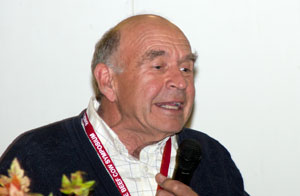50 Years of Reproductive Technology
by Kasey Miller for Angus Productions Inc.
MITCHELL, Neb. (Nov. 30, 2011) — Prior to the 20th century, reproductive management of both beef and dairy cattle consisted of buying from a neighbor a bull with a great phenotype, but little genetic information. Today, its much the same, except we have much more genetic information, said George Siedel, distinguished professor of biomedical sciences at Colorado State University. The amount and quality of beef produced per cow or per unit input of feed and labor have increased dramatically because of genetic change.
Seidel said four things are accomplished more efficiently or rapidly through advancement in reproductive technology:
- getting the cow pregnant;
- genetic improvement;
- convenience/efficiency; and
- trying new approaches.

George Siedel
A foundation, Siedel said, is required in management, nutrition, herd health and usually crossbreeding. He mentioned that most wrecks happen when there is a problem with nutrition.
Seidel listed what he considered the most significant reproductive technologies in both routine use, and research and niche applications. The top 10 technologies for routine use were artificial insemination (AI); electroejaculation; vaccination; cryopreservation of sperm; readily available hormones (progesterone, GnRH, prostaglandin F-2 alpha, FSH and others); body condition scoring; expected progeny differences (EPDs); ultrasound (ovarian status, pregnancy, sexing, and pathology of uterus, ovary and testis); sexing embryos, fetuses and sperm; and genomics.
His top 10 research and niche applications were hormone assays, superovulation, nonsurgical embryo recovery and transfer, cryopreservation of embryos and oocytes, in vitro fertilization and sperm injection, splitting embryos, transvaginal oocyte aspiration, cloning by nuclear transplantion, preimplantation genetic diagnosis, and transgenic procedures.
He said the most important, and what everyone already uses, are vaccinations, electroejaculation, body condition scoring and EPDs for bulls.
“Without these foundational tools,” Seidel said, “the other razzle-dazzle reproductive tools are not very valuable.”
The benefits from these tools include genetic superiority, females pregnant earlier, calving ease, genetically polled cattle, concentrated calving, sex selection and one-day AI.
“Sex is the most important genetic trait,” said Seidel.
He mentioned the possibilities of sexed semen. Sexed semen is 90% pure and costs $20 extra per dose, but is 10 percentage points lower in fertility. He added that sexed semen is good for use in first-calf heifers to have heifers and less dystocia is seen.
He predicted that in the next five to 10 years, procedures such as ovulation synchronization and sexing semen will be further refined, in addition to fetal programming. Genomics will improve rates of genetic gain for numerous traits. He added that technology will continue to displace labor, such as eliminating detection of estrus and minimizing dystocia.
He concluded that there are many exciting options for reproduction technology advancements.
To see the PowerPoint that accompanied Seidel's presentation, click here.
The biennial Range Beef Cow Symposium was hosted Nov. 29-Dec. 1 at the Mitchell Events Center, Mitchell, Neb., by the cooperative extension and animal science departments of the University of Nebraska-Lincoln, South Dakota State University, Colorado State University and the University of Wyoming. Comprehensive coverage of the event is provided online at www.rangebeefcow.com, an event coverage site provided by Angus Productions Inc. (API), publisher of the Angus Journal and the Angus Beef Bulletin.
Editor’s Note: API's coverage of the event is made available for distribution to all media via an agreement with the Range Beef Cow Symposium Committee and API. Headquartered in Saint Joseph, Mo., API publishes the Angus Journal, the Angus Beef Bulletin, the Angus Beef Bulletin EXTRA, and the Angus e-List, as well as providing online coverage of events and topics pertinent to cattlemen through the API Virtual Library. For questions about this site, or to notifiy us of broken links, click here.

